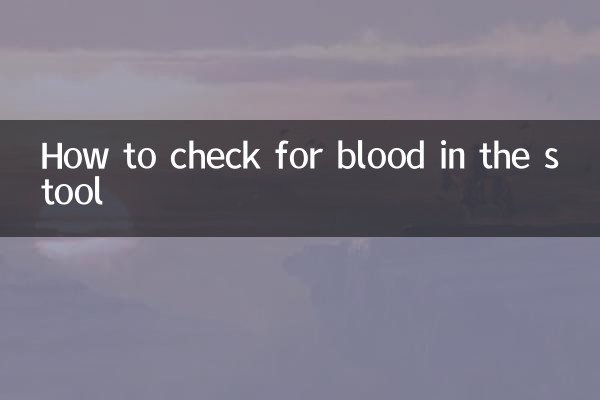How to check for blood in the stool
Blood in the stool is a common clinical symptom that may be caused by a variety of diseases, such as hemorrhoids, anal fissures, intestinal inflammation, polyps or tumors. It is crucial to promptly detect the cause of bloody stools so that early diagnosis and treatment can be achieved. This article will introduce in detail the relevant examination methods for blood in the stool, and attach structured data to help you better understand the examination process for blood in the stool.
1. Common causes of bloody stools

There are many causes of blood in the stool. Here are some common causes:
| Cause | Features |
|---|---|
| hemorrhoid | Bright red blood, often attached to the surface of the feces, accompanied by anal pain or itching |
| anal fissure | Severe pain during defecation, bleeding after defecation, bright red blood |
| Intestinal inflammation (such as ulcerative colitis) | Mucus and bloody stools, accompanied by diarrhea and abdominal pain |
| Intestinal polyps or tumors | Dark red or black blood in the stool, which may be accompanied by weight loss or anemia |
| gastrointestinal bleeding | Black stool (tarry stool), possibly with vomiting blood |
2. How to check for blood in the stool
The examination of blood in the stool requires selecting an appropriate method based on the patient's symptoms and medical history. The following are common examination methods:
| Check items | Check content | Applicable situations |
|---|---|---|
| Digital anal examination | Doctor using fingers to examine anus and rectum | Preliminary diagnosis of hemorrhoids, anal fissure or rectal tumors |
| fecal occult blood test | Detects whether there is blood invisible to the naked eye in the stool | Screening for gastrointestinal bleeding |
| colonoscopy | Viewing the entire large intestine through an endoscope | Diagnose intestinal inflammation, polyps or tumors |
| Gastroscopy | Viewing the esophagus, stomach, and duodenum through an endoscope | Diagnosing upper gastrointestinal bleeding |
| Imaging examinations (such as CT, MRI) | Observing the structure of the digestive tract through imaging technology | Assist in diagnosing tumors or vascular malformations |
3. Precautions for blood in stool examination
1.Preparation before inspection:Some examinations (such as colonoscopy) require intestinal cleaning in advance, and patients need to take laxatives or perform enemas as directed by the doctor.
2.Diet modification:Certain tests (such as fecal occult blood tests) may require avoiding foods such as red meat and animal liver to avoid affecting the results.
3.Tell your doctor your medical history:If you have a bleeding disorder, a history of allergies, or are taking anticoagulant drugs, you need to inform your doctor in advance.
4.Post-examination care:You may experience slight discomfort after some examinations (such as endoscopy), and you need to pay attention to rest and dietary adjustments.
4. Treatment suggestions for blood in the stool
Treatment of hematochezia requires a personalized plan based on the cause. Here are some common treatment suggestions:
| Cause | Treatment recommendations |
|---|---|
| hemorrhoid | Adjust your diet, use hemorrhoid cream or medicine, and severe cases may require surgery |
| anal fissure | Keep the stool smooth, use local medication, and perform surgery if necessary |
| intestinal inflammation | Treatment with anti-inflammatory drugs and, if necessary, immunosuppressants |
| polyps or tumors | Endoscopic resection or surgical treatment |
5. Measures to prevent blood in the stool
1.Diet modification:Eat more high-fiber foods (such as vegetables, fruits, whole grains) and avoid spicy and irritating foods.
2.Keep your bowel movements clear:Develop the habit of regular bowel movements and avoid sitting for long periods of time or straining to defecate.
3.Moderate exercise:Promote intestinal peristalsis and prevent constipation.
4.Regular physical examination:Especially for people over 40 years old, it is recommended to have regular intestinal examinations.
Blood in the stool may be a sign of a serious disease. Timely medical treatment and completion of relevant examinations are the key to diagnosis and treatment. I hope that through the introduction of this article, you can have a clearer understanding of the detection methods of blood in the stool.

check the details

check the details